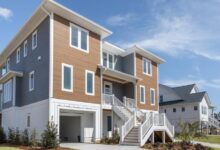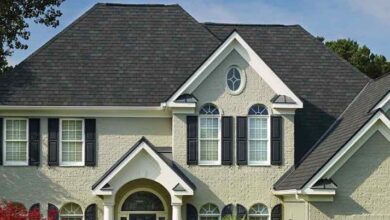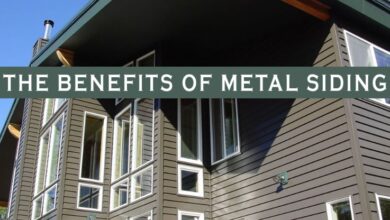Exterior Structure Seismic Retrofitting
Seismic retrofitting is the process of strengthening existing structures to improve their resistance to earthquake forces. This is crucial in areas prone to seismic activity, as it helps to protect lives and property by reducing the risk of building collapse or significant damage during an earthquake. While seismic retrofitting involves various aspects of a building’s structure, this article will focus specifically on the techniques used to enhance the earthquake resistance of the exterior structure.
Understanding the Importance of Exterior Structure Seismic Retrofitting
The exterior structure of a building, including its walls, foundations, and roof, plays a vital role in its overall stability during an earthquake. These components are subjected to significant stress and strain as the ground shakes, and their ability to withstand these forces is critical for preventing structural failure. Strengthening the exterior structure through seismic retrofitting can significantly improve a building’s capacity to resist earthquake damage.
Why Focus on the Exterior Structure?
Several factors contribute to the importance of focusing on the exterior structure during seismic retrofitting:
- Load Transfer: The exterior structure is responsible for transferring loads from the roof and upper floors down to the foundation. During an earthquake, these loads become amplified, and a weak exterior structure can lead to instability and collapse.
- Shear Resistance: Exterior walls are crucial for resisting shear forces, which are horizontal forces that can cause a building to distort and collapse. Strengthening these walls improves the building’s ability to withstand these forces.
- Foundation Stability: A strong foundation is essential for anchoring the building to the ground and preventing it from overturning during an earthquake. Retrofitting the foundation can improve its stability and prevent soil liquefaction.
- Overall Stability: Strengthening the exterior structure enhances the overall stability of the building, making it more resilient to earthquake forces. This reduces the risk of catastrophic failure and protects the occupants and contents of the building.
Common Seismic Retrofitting Techniques for Exterior Structures
Several techniques can be used to seismically retrofit the exterior structure of a building. The specific techniques used will depend on the building’s structural characteristics, the level of seismic hazard in the area, and the budget available for the project. Some of the most common techniques include:
Foundation Retrofitting
The foundation is the most critical part of a building’s structure during an earthquake. Strengthening the foundation can significantly improve the building’s overall earthquake resistance. Common foundation retrofitting techniques include:
Concrete Shear Walls: Adding concrete shear walls to the foundation can increase its resistance to lateral forces. These walls act as stiffeners, preventing the foundation from racking or overturning during an earthquake. This is particularly effective for cripple walls found in older homes.
Steel Bracing: Steel bracing can be used to reinforce the foundation and prevent it from shifting or collapsing. Steel braces are typically attached to the foundation walls and the floor joists above, providing additional support and stability.
Reinforced Concrete Overlays: Applying a reinforced concrete overlay to the existing foundation can increase its strength and durability. This involves adding a layer of concrete reinforced with steel rebar to the existing foundation walls, providing additional support and resistance to cracking.
Soil Improvement: In areas with poor soil conditions, soil improvement techniques may be necessary to improve the foundation’s stability. This can involve methods such as soil compaction, soil stabilization, or the installation of deep foundations, such as piles or piers.
Wall Retrofitting
Exterior walls are responsible for resisting shear forces and transferring loads from the roof and upper floors down to the foundation. Strengthening these walls is crucial for preventing collapse during an earthquake. Common wall retrofitting techniques include:
Shear Wall Installation: Adding shear walls to the exterior walls can significantly increase their resistance to lateral forces. Shear walls are typically constructed of plywood, oriented strand board (OSB), or concrete and are designed to resist racking and prevent collapse. Proper nailing and attachment to framing is critical.
Steel Frame Reinforcement: Adding a steel frame to the exterior walls can provide additional support and resistance to earthquake forces. The steel frame is typically attached to the existing walls and anchored to the foundation, providing a strong and stable framework.
Fiber-Reinforced Polymer (FRP) Composites: FRP composites can be used to strengthen existing walls without significantly increasing their weight. These materials are applied to the surface of the walls and bonded with epoxy, providing additional strength and stiffness.
Shotcrete Application: Applying shotcrete, a type of sprayed concrete, to the exterior walls can increase their strength and durability. Shotcrete is typically applied in multiple layers and reinforced with steel mesh, providing a strong and resilient surface.
Roof Retrofitting
The roof is the uppermost part of the building and is subjected to significant stress during an earthquake. Strengthening the roof can prevent it from collapsing and protect the occupants below. Common roof retrofitting techniques include:
Roof Diaphragm Strengthening: The roof diaphragm is the structural element that transfers lateral loads from the roof to the walls. Strengthening the roof diaphragm can improve its ability to resist these forces. This can be achieved by adding plywood sheathing, reinforcing existing sheathing, or installing metal connectors.
Truss and Rafter Reinforcement: Reinforcing the roof trusses and rafters can increase their strength and stability. This can be achieved by adding additional bracing, connecting plates, or replacing damaged or deteriorated members.
Connection Strengthening: Strengthening the connections between the roof and the walls can prevent the roof from separating from the building during an earthquake. This can be achieved by adding metal connectors, bolts, or straps.
Lightweight Roofing Materials: Replacing heavy roofing materials with lightweight alternatives can reduce the overall load on the building and improve its earthquake resistance. Lightweight roofing materials such as metal roofing or composite shingles can significantly reduce the stress on the structure during an earthquake.
Materials Used in Exterior Structure Seismic Retrofitting
The choice of materials used in exterior structure seismic retrofitting is crucial for ensuring the effectiveness and durability of the retrofit. Some of the most commonly used materials include:
Concrete
Concrete is a versatile and durable material that is widely used in seismic retrofitting. It can be used to strengthen foundations, walls, and roofs, and it is relatively inexpensive and readily available. Concrete is often reinforced with steel rebar to increase its tensile strength and resistance to cracking.
Steel
Steel is another common material used in seismic retrofitting. It is strong, durable, and resistant to corrosion. Steel can be used to reinforce foundations, walls, and roofs, and it is particularly effective for resisting tension and shear forces. Steel is often used in the form of steel frames, bracing, and connectors.
Wood
Wood is a lightweight and relatively inexpensive material that can be used in seismic retrofitting. It is often used for shear walls, roof diaphragms, and other structural components. Wood must be properly treated to prevent rot and decay, and it should be connected to the structure using appropriate fasteners.
Fiber-Reinforced Polymer (FRP) Composites
FRP composites are a relatively new class of materials that are gaining popularity in seismic retrofitting. These materials are lightweight, strong, and resistant to corrosion. They can be used to strengthen walls, columns, and other structural components, and they can be applied to the surface of the existing structure without significantly increasing its weight.
Epoxy Adhesives
Epoxy adhesives are used to bond FRP composites to the existing structure. They are strong, durable, and resistant to moisture and chemicals. Epoxy adhesives must be properly applied to ensure a strong and lasting bond.
The Seismic Retrofitting Process
The seismic retrofitting process typically involves the following steps:
Assessment and Evaluation
The first step is to assess and evaluate the building’s structural vulnerability to earthquakes. This involves a thorough inspection of the building’s foundation, walls, roof, and other structural components. A structural engineer will typically conduct this assessment and identify areas that need to be strengthened.
Design and Planning
Based on the assessment, a structural engineer will develop a seismic retrofitting plan that outlines the specific techniques and materials that will be used to strengthen the building. The plan will also include detailed drawings and specifications for the retrofit work. This also includes permitting, which can vary greatly depending on location.
Permitting and Approvals
Before any retrofit work can begin, it is necessary to obtain the necessary permits and approvals from the local building department. This may involve submitting the seismic retrofitting plan for review and approval and paying permit fees.
Construction and Implementation
Once the permits and approvals have been obtained, the construction and implementation phase can begin. This involves hiring a qualified contractor to perform the retrofit work according to the seismic retrofitting plan. The contractor will typically install new structural components, reinforce existing components, and connect them to the building’s structure.
Inspection and Verification
After the retrofit work has been completed, it is necessary to have the work inspected and verified by a structural engineer. This ensures that the retrofit work has been performed correctly and that the building meets the required seismic standards.
Cost Considerations for Exterior Structure Seismic Retrofitting
The cost of exterior structure seismic retrofitting can vary widely depending on several factors, including:
- The size and complexity of the building: Larger and more complex buildings will typically cost more to retrofit than smaller and simpler buildings.
- The extent of the retrofit work: The more extensive the retrofit work, the higher the cost. For example, a full foundation retrofit will typically cost more than simply strengthening the walls.
- The materials used: The choice of materials can also affect the cost of the retrofit. For example, using FRP composites can be more expensive than using concrete or steel.
- The location of the building: The location of the building can also affect the cost of the retrofit. In areas with high labor costs, the retrofit will typically cost more.
- The contractor’s fees: The contractor’s fees can also vary depending on their experience, reputation, and overhead costs.
It is important to obtain multiple bids from qualified contractors before selecting one to perform the retrofit work. This will help to ensure that you are getting a fair price for the work. Consider long-term benefits like reduced insurance premiums after a retrofit.
Benefits of Exterior Structure Seismic Retrofitting
The benefits of exterior structure seismic retrofitting are numerous and significant. Some of the key benefits include:
- Improved Safety: Seismic retrofitting can significantly improve the safety of a building during an earthquake. By strengthening the building’s structure, it reduces the risk of collapse and protects the occupants from injury or death.
- Reduced Damage: Seismic retrofitting can also reduce the amount of damage that a building sustains during an earthquake. By strengthening the building’s structure, it can withstand stronger forces and prevent costly repairs.
- Increased Property Value: Seismic retrofitting can increase the value of a property. A seismically retrofitted building is more attractive to buyers and renters, as it offers greater safety and security.
- Lower Insurance Premiums: Some insurance companies offer lower premiums for seismically retrofitted buildings. This is because the risk of damage is lower, and the insurance company is less likely to have to pay out a claim.
- Community Resilience: Seismic retrofitting can improve the overall resilience of a community to earthquakes. By strengthening buildings, it reduces the risk of widespread damage and disruption, allowing the community to recover more quickly after an earthquake.
Case Studies of Successful Exterior Structure Seismic Retrofitting Projects
Numerous successful exterior structure seismic retrofitting projects have been completed around the world. These projects demonstrate the effectiveness of seismic retrofitting in improving the earthquake resistance of buildings.
Case Study 1: The San Francisco City Hall
The San Francisco City Hall is a historic building that was severely damaged in the 1989 Loma Prieta earthquake. The building was subsequently seismically retrofitted using a variety of techniques, including the installation of steel frames, concrete shear walls, and FRP composites. The retrofitted building is now much more resistant to earthquakes and is considered a model for seismic retrofitting.
Case Study 2: The Getty Center
The Getty Center in Los Angeles is a complex of buildings that houses a museum, research institute, and other cultural institutions. The buildings were designed to be earthquake-resistant from the outset, but they were further strengthened using seismic retrofitting techniques. The retrofitted buildings are now among the safest in the world.
Case Study 3: Residential Retrofits in California
California has implemented programs to encourage seismic retrofitting of residential homes, particularly older wood-frame structures. These retrofits often involve bolting the foundation to the framing, strengthening cripple walls, and reinforcing connections. Studies have shown that these retrofits significantly reduce damage during earthquakes.
The Future of Exterior Structure Seismic Retrofitting
The field of exterior structure seismic retrofitting is constantly evolving, with new techniques and materials being developed all the time. Some of the key trends in the field include:
Advanced Materials
The development of new and improved materials, such as high-strength concrete, FRP composites, and smart materials, is enabling engineers to design more effective and efficient seismic retrofits.
Non-Destructive Testing
The use of non-destructive testing methods, such as ground-penetrating radar and ultrasonic testing, is allowing engineers to assess the condition of existing structures without damaging them.
Performance-Based Design
The adoption of performance-based design methods is allowing engineers to design seismic retrofits that meet specific performance objectives, such as minimizing damage or maintaining occupancy.
Building Information Modeling (BIM)
The use of BIM is allowing engineers to create detailed three-dimensional models of buildings, which can be used to simulate the effects of earthquakes and to design more effective seismic retrofits.
Conclusion
Exterior structure seismic retrofitting is a crucial investment in the safety and resilience of buildings in earthquake-prone areas. By strengthening the foundation, walls, and roof, seismic retrofitting can significantly improve a building’s ability to withstand earthquake forces and protect its occupants and contents. While the cost of seismic retrofitting can be significant, the benefits are numerous and far-reaching. As technology advances and new materials are developed, seismic retrofitting will become even more effective and affordable, making it an essential part of building safety in earthquake-prone regions.
If you own a building in an earthquake-prone area, it is important to consider seismic retrofitting to protect your investment and the lives of those who use the building. Consult with a qualified structural engineer to assess your building’s vulnerability and develop a seismic retrofitting plan that meets your needs and budget.









